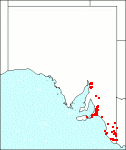Family: Orchidaceae
Cyrtostylis reniformis
Citation:
R. Br., Prod. Fl. Nov. Holl. 322. (1810).
Synonymy: Acianthus reniformis (R. Br.) Schltr., Bot. Jb. 39:39 (1906).
, Caladenia reniformis Common name: Gnat orchid, mosquito orchid.
Description:
A slender plant, 7-15 cm high; leaf orbicular-cordate, 2-3.5 cm long, green on both sides, the underside glistening with numerous swollen pelucid cells.
Flowers generally 3-6, but sometimes solitary, reddish-brown, maroon or rarely verdant-green, sessile or on very short pedicels; dorsal sepal 8-10 mm long; lateral sepals 8-9.5 mm; petals narrower than the sepals but same length; labellum oblong or ovate-oblong, with conspicuous lateral veins, as long as or slightly longer than the dorsal sepal and 3-5 mm wide; column c. 6 mm long, semiterete, dilated at each end; anther rather globose and pointless; pollinia narrow-ovoid, each pair attached to a separate viscid disk.
Published illustration:
Fitzgerald (1878) Australian orchids, Vol. 1, pt 4, as Cyrtostylis remformis; Hoffman & Brown (1984) Orchids of south-west Australia, p. 190 as Acianthus reniformis; Woolcock (1984) Australian terrestrial orchids, pl. 1A as Acianthus reniformis.
|
|
Distribution:
|
Forming small to large, often dense colonies.
S.Aust.: FR, NL, MU, SL, KI, SE. All States except the N.T. New Zealand.
|
Conservation status:
native
Flowering time: July — Oct.
|

SA Distribution Map based
on current data relating to
specimens held in the
State Herbarium of South Australia
|
Biology:
An early flowering form occurs on limestone, sand or loams in open forest or heathland, often littoral, in areas receiving 300-600 mm mean annual rainfall. A late flowering form forms smaller colonies on clay loams in heavy forest usually on steep hillsides in areas receiving more than 600 mm rain. The early-flowering form (July-August) has yellow-green leaves and reddish-brown flowers with subacute labellum c. 10 x 4-5 mm and the later-flowering form (Sept.-Oct.) has blue-green leaves, and maroon-brown flowers with a small truncate labellum c. 8 x c. 3 mm. They are rarely sympatric but where they found together no intermediates have been noted. Both forms are common.
Author:
Not yet available
|

